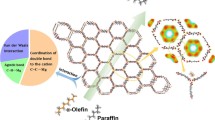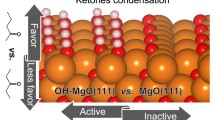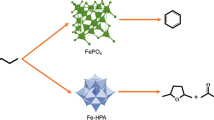Abstract
In a recent paper (Zuo et al., Appl Catal A 408:130–136, 2011), the mechanism of dimethyl ether (DME) synthesis from methanol dehydration over γ-Al2O3 (110) was studied using density functional theory (DFT). Using the same method, the effect of surface hydroxyls on γ-Al2O3 in liquid paraffin during DME synthesis from methanol dehydration is investigated. It is found that DME is mainly formed from two adsorbed CH3O groups via methanol dehydrogenation on both dehydrated and hydrated γ-Al2O3 in liquid paraffin. No close correlation between catalytic activity and acid intensity was found. Before and after water adsorption at typical catalytic conditions (e.g., 553 K), the reaction rate is not obviously changed on γ-Al2O3(100) surface in liquid paraffin, but the reaction rate decreases by about 11 times on the (110) in liquid paraffin. Considering the area of the (110) and (100) surfaces under actual conditions, the catalytic activity decreased mainly because the Al3 sites on the (110) surface gradually become inactive. Catalytic activity decreased mainly due to surface hydrophilicity. The calculated results were consistent with the experiment.

The reaction rate decreases by about 11 times on the (110)/liquid paraffin interface before and after water adsorption at typical catalytic conditions (e.g., 553 K).









Similar content being viewed by others
References
Pan YX, Liu CJ (2007) DFT study on pathways of partial oxidation of DME under cold plasma conditions. Fuel Process Technol 88:967–976
Naik SP, Ryu T, Bui V, Miller JD, Drinnan NB, Zmierczak W (2011) Synthesis of DME from CO2/H2 gas mixture. Chem Eng J 167:362–368
Baltes C, Vukojević S, Schüth F (2008) Correlations between synthesis, precursor, and catalyst structure and activity of a large set of CuO/ZnO/ZnO/Al2O3 catalysts for methanol synthesis. J Catal 258:334–344
Flores JH, Peixoto DPB, Appel LG, de Avillez RR, Pais da Silva MI (2011) The influence of different methanol synthesis catalysts on direct synthesis of DME from syngas. Catal Today 172:218–225
Abu-Dahrieh J, Rooney D, Goguet A, Saih Y (2012) Activity and deactivation studies for direct dimethyl ether synthesis using CuO–ZnO–Al2O3 with NH4ZSM-5, HZSM-5 or γ-Al2O3. Chem Eng J 203:201–211
Breman BB, Beenackers AACM, Schuurman HA, Oesterholt E (1995) Kinetics of the gas-slurry methanol-higher alcohol synthesis from CO/CO2/H2 over a Cs/Cu/ZnO/Al2O3 catalyst, including simultaneous formation of methyl esters and hydrocarbons. Catal Today 24:5–14
Yang RQ, Yu XC, Zhang Y, Li WZ, Tsubaki N (2008) A new method of low-temperature methanol synthesis on Cu/ZnO/Al2O3 catalysts from CO/CO2/H2. Fuel 87:443–450
Suh YW, Moon SH, Rhee HK (2000) Active sites in Cu/ZnO/ZrO2 catalysts for methanol synthesis from CO/H2. Catal Today 63:447–452
Li J, Zhang QJ, Long X, Qi P, Liu ZT, Liu ZW (2012) Hydrogen production for fuel cells via steam reforming of dimethyl ether over commercial Cu/ZnO/Al2O3 and zeolite. Chem Eng J 187:299–305
Fan JC, Chen CQ, Zhao J, Huang W, Xie KC (2010) Effect of surfactant on structure and performance of catalysts for DME synthesis in slurry bed. Fuel Process Technol 91:414–418
Gao ZH, Hao LF, Huang W, Xie KC (2005) A novel liquid-phase technology for the preparation of slurry catalysts. Catal Lett 102:139–141
Jain JR, Pillai CN (1967) Catalytic dehydration of alcohols over alumina: mechanism of ether formation. J Catal 9:322–330
Schiffino RS, Merrill RP (1993) A mechanistic study of the methanol dehydration reaction on γ-alumina catalyst. J Phys Chem 97:6425–6435
Zuo ZJ, Huang W, Han PD, Gao ZH, Li Z (2011) Theoretical studies on the reaction mechanisms of AlOOH- and γ-Al2O3-catalysed methanol dehydration in the gas and liquid phases. Appl Catal A 408:130–136
Gayubo AG, Aguayo AT, Morán AL, Olazar M, Bilbao J (2002) Role of water in the kinetic modeling of catalyst deactivation in the MTG process. AIChE J 48:1561–1571
Gayubo AG, Eren J, Sierra I, Olazar M, Bilbao J (2005) Deactivation and regeneration of hybrid catalysts in the single-step synthesis of dimethyl ether from syngas and CO. Catal Today 106:265–270
Mei D, Ge Q, Kwak JH, Kim DH, Szanyi J, Peden CHF (2008) Adsorption and formation of BaO overlayers on γ-Al2O3 surfaces. J Phys Chem C 112:18050–19060
Cheng L, Ge Q (2008) Effect of BaO morphology on NOx abatement: NO2 interaction with unsupported and γ-Al2O3-supported BaO. J Phys Chem C 112:16924–16931
Cheng L, Ge Q (2007) Effect of γ-Al2O3 substrate on NO2 interaction with supported BaO clusters. Surf Sci 601:L65–L68
Digne M, Sautet P, Raybaud P, Euzen P, Toulhoat H (2004) Use of DFT to achieve a rational understanding of acid–basic properties of γ-alumina surfaces. J Catal 226:54–68
Raybaud P, Digne M, Iftimie R, Wellens W, Euzen P, Toulhoat H (2001) Morphology and surface properties of boehmite (γ-AlOOH): a density functional theory study. J Catal 201:236–246
Digne M, Raybaud P, Sautet P, Guillaume D, Toulhoat H (2008) Atomic scale insights on chlorinated gamma-alumina surfaces. J Am Chem Soc 130:11030–11039
Ionescu A, Allouche A, Aycard JP, Rajzmann M (2002) Structure and stability of aluminum hydroxides: a theoretical study. J Phys Chem B 106:5561–5562
Pan YX, Liu CJ, Ge QF (2010) Effect of surface hydroxyls on selective CO2 hydrogenation over Ni4/γ-Al2O3: a density functional theory study. J Catal 272:227–234
Zhang RG, Wang BJ, Liu HY, Ling LX (2011) Effect of surface hydroxyls on CO2 hydrogenation over Cu/γ-Al2O3 catalyst: a theoretical study. J Phys Chem C 115:19811–19818
Feng G, Huo CF, Deng CM, Huang L, Li YW, Wang JG, Jiao HJ (2009) Isopropanol adsorption on γ-Al2O3 surfaces: a computational study. J Mol Catal A 304:58–64
Zuo ZJ, Han PD, Hu JS, Huang W (2012) Effect of surface hydroxyls on DME and methanol adsorption over γ-Al2O3 (hkl) surfaces and solvent effects: a density functional theory study. J Mol Model 18:5107–5111
Digne M, Sautet P, Raybaud P, Euzen P, Toulhoat H (2002) Hydroxyl groups on γ-Alumina surfaces: a DFT study. J Catal 211:1–5
Jennison DR, Schultz PA, Sullivan JP (2004) Evidence for interstitial hydrogen as the dominant electronic defect in nanometer alumina films. Phys Rev B 69:041405
Cai SH, Rashkeev SN, Pantelides ST, Sohlberg K (2002) Atomic scale mechanism of the transformation of γ-alumina to θ-alumina. Phys Rev Lett 89:235501
Sohlberg K, Pennycook SJ, Pantelides ST (1999) Hydrogen and the structure of transition aluminas. J Am Chem Soc 121:7493–7499
Krokidis X, Raybaud P, Gobichon AE, Rebours B, Euzen P, Toulhoat H (2001) Theoretical study of the dehydration process of boehmite to γ-Alumina. J Phys Chem B 105:5121–5130
Nortier P, Fourre P, Mohammed Saad AB, Saur O, Lavalley JC (1990) Effects of crystallinity and morphology on the surface properties of alumina. Appl Catal 61:141–160
Szaleniec M, Drzewiecka-Matuszek A, Witko M, Hejduk P (2013) Ammonium adsorption on Brønsted acidic centers on low-index vanadium pentoxide surfaces. J Mol Model. doi:10.1007/s00894-013-1951-4
Wang SG, Cao DB, Li YW, Wang JG, Jiao HJ (2005) Chemisorption of CO2 on the nickel surfaces. J Phys Chem C 109:18956–18963
Delley B (1990) An all-electron numerical method for solving the local density functional for polyatomic molecules. J Chem Phys 92:508–517
Delley B (2000) From molecules to solids with the DMol3 approach. J Chem Phys 113:7756–7764
Perdew JP, Wang Y (1992) Accurate and simple analytic representation of the electron-gas correlation energy. Phys Rev B 45:13244–13249
Hohenberg P, Kohn W (1964) Inhomogeneous electron gas. Phys Rev B 136:864–871
Kohn W, Sham LJ (1965) Self-consistent equations including exchange and correlation effects. Phys Rev A 140:1133–1138
Zuo ZJ, Sun LL, Huang W, Han PD, Li ZH (2010) Surface properties of copper in different solvent mother solutions: a density functional theory study. Appl Catal A 375:181–187
Singh A, Ganguly B (2008) DFT study of urea interaction with potassium chloride surfaces. Mol Simul 34:973–979
Zhang RG, Ling LX, Wang BJ (2012) Density functional theory analysis of carbonyl sulfide hydrolysis: effect of solvation and nucleophile variation. J Mol Model 18:1255–1262
Mojica ERE (2013) Screening of different computational models for the preparation of sol–gel imprinted materials. J Mol Model. doi:10.1007/s00894-013-1928-3
Zuo ZJ, Huang W, Han PD, Li ZH (2010) Solvent effects for CO and H2 adsorption on Cu2O (1 1 1) surface: a density functional theory study. Appl Surf Sci 256:2357–2362
Halgren TA, Lipscomb WN (1977) The synchronous-transit method for determining reaction pathways and locating molecular transition states. Chem Phys Lett 49:225–232
Wang SG, Liao XY, Hu J, Cao DB, Li YW, Wang JG, Jiao HJ (2007) Kinetic aspect of CO2 reforming of CH4 on Ni(1 1 1): a density functional theory calculation. Surf Sci 601:1271–1284
Maresca O, Allouche A, Aycard JP, Rajzmann M, Clemendot S, Hutschka F (2000) Quantum study of the active sites of the γ-alumina surface: chemisorption and adsorption of water, hydrogen sulfide and carbon monoxide on aluminum and oxygen sites. J Mol Struct THEOCHEM 505:81–94
Maresca O, Ionescu A, Allouchea A, Aycard JP, Rajzmann M, Hutschka F (2003) Quantum study of the active sites of the γ alumina surface (II): QM/MM (LSCF) approach to water, hydrogen disulfide and carbon monoxide adsorption. J Mol Struct THEOCHEM 620:119–128
Arrouvel C, Toulhoat H, Breysse M, Raybaud P (2004) Effects of PH2O, PH2S, PH2 on the surface properties of anatase-TiO2 and γ-Al2O3: a DFT study. J Catal 226:260–270
Sung DM, Kim YH, Park ED, Yie JE (2012) Role of surface hydrophilicity of alumina in methanol dehydration. Catal Commun 20:63–67
Yang YX, Evans J, Rodriguez JZ, White MG, Liu P (2010) Fundamental studies of methanol synthesis from CO2 hydrogenation on Cu(111), Cu clusters, and Cu/ZnO(0001). Phys Chem Chem Phys 12:9909–9917
Acknowledgments
The authors gratefully acknowledge the financial support of this study by the National Natural Science Foundation of China (Grant No.20676087), China Postdoctoral Science Foundation Funded Project (Grant No.2012M510784), Shanxi Province Science Foundation for Youths (Grant No.012021005-1), Natural Science Foundation of Shanxi Province (Grant No. 2012011046–1), Special/Youth Foundation of Taiyuan University of Technology (No. 2012L042). The authors especially thank for two anonymous reviewers for their valuable suggestions on the quality improvement of our present paper.
Author information
Authors and Affiliations
Corresponding author
Rights and permissions
About this article
Cite this article
Zuo, Zj., Wang, L., Han, Pd. et al. Effect of surface hydroxyls on dimethyl ether synthesis over the γ-Al2O3 in liquid paraffin: a computational study. J Mol Model 19, 4959–4967 (2013). https://doi.org/10.1007/s00894-013-1993-7
Received:
Accepted:
Published:
Issue Date:
DOI: https://doi.org/10.1007/s00894-013-1993-7




